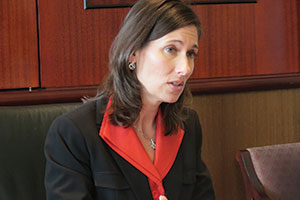NTSB’s Hersman Frustrated by Unresolved Safety Issues

This story appears in the Feb. 10 print edition of Transport Topics.
Stubbornly high out-of-service rates in trucking and enduring arguments over safety data are among the issues that remain unresolved, despite the efforts by government officials and industry executives, National Transportation Safety Board Chairman Deborah Hersman said.
In a Feb. 4 forum with Transport Topics editors and reporters, Hersman said she is frustrated that truck out-of-service rates seem stuck at double digits despite numerous vehicle inspections and that truck-safety regulators cannot seem to master data collection and application.
“From a safety perspective, one of the things that just confounds me is that year after year, even after millions of roadside inspections, we still see a 20% out-of-service rate,” Hersman said.
In last year’s Roadcheck safety inspection event, the truck out-of-service rate dipped to 20.6% from 20.9% in 2012, according to the Commercial Vehicle Safety Alliance.
Hersman, who has led the independent federal agency since 2009, said her disappointment extended from carrier managers to government officials.
Noting a new Government Accountability Office report that criticized part of the Federal Motor Carrier Safety Administration’s Compliance, Safety, Accountability program, Hersman said it sounded similar to complaints about the SafeStat system from the late 1990s, which predates the FMCSA.
“Twenty years ago, we kind of thought if we created a new modal administration at [the U.S. Department of Transportation] and took the Office of Motor Carriers out from underneath the Federal Highway Administration we’d actually have the focus we need, but we’re still kind of struggling,” she said, comparing the repetition in transportation problems to the movie “Groundhog Day.”
CSA was designed to target carriers and drivers for inspection based on their safety performance. It is the successor to SafeStat.
Hersman, 43, started her transportation career as a Democratic aide on Capitol Hill in the 1990s. She has been an NTSB member since 2004.
The NTSB has two main functions:
• By congressional mandate it is to investigate major transportation accidents, including all civilian air crashes.
• To make safety policy recommendations based on major trends.
As a result, in November the NTSB sent a report critical of FMCSA to the DOT, urging an audit be done on FMCSA oversight activities.
“For sure, this is the hardest we’ve come down on FMCSA in some time,” said Hersman, whose researchers found that in four major incidents, motor carriers passed compliance reviews days or weeks before being involved in fatal accidents.
“After the crash, those things rise up to be enough to put them out of business,” she said. “What happened during the first four compliance reviews? . . . Was there a problem with a single operator or maybe their maintenance?”
“FMCSA needs to deploy its resources better,” she added.
Transportation Secretary Anthony Foxx responded to Hersman in a letter Feb. 3, saying FMCSA started an internal investigation immediately after one of the accidents cited by NTSB. He also said his department’s Safety Council is performing an independent review.
But in spite of the NTSB report, Hersman did credit FMCSA Administrator Anne Ferro with working “really hard to try to get a common-sense, rational, data-driven approach to what they’re doing.”
A portion of the editorial forum included Bill Graves, president of American Trucking Associations, who discussed ways to improve highway safety, including better adoption of electronic logging devices and slowing down all vehicles.
In terms of pursuing vehicle safety more broadly, Hersman sees the highway funding debate now before Congress as an opportunity to pass safety laws. Recent history shows, she said, that stand-alone safety bills tend not to be enacted into laws. The exceptions to that are responses to well-publicized disasters.
More commonly, safety preferences become law when they are wrapped into large, necessary bills such as a multiyear highway-funding plan.
Safety programs “need to be swept up into a must-pass package. They do get picked up when those omnibus bills move forward,” she said.
As for the agency’s preferences on which safety issues should become law, NTSB published its annual Top 10 list in January and three had a highway safety emphasis: eliminating distracted driving, driving while impaired and better safety for vehicle occupants. The other topics affected aviation, trains, ships and pipelines.
Hersman said the distraction issue cannot be solved completely with hands-free devices. While a driver should devote his or her hands to vehicle operation, the matter of divided attention is critical because of “cognitive distraction.”
She told of a bus accident investigation where a driver talking on a hands-free phone struck a bridge with low clearance even though there were multiple warning signs.
“When our investigators interviewed the driver afterward and asked him if he’d seen the signs, he said he didn’t even see the bridge until after he hit it,” Hersman recounted. “We do not believe that hands-free is any safer than handheld.”
The public attachment to cellphones show that many people “clearly value productivity and convenience over safety,” she said.
Hersman recalled a recent bus trip with her husband that allowed her to look down into cars. She said her husband was appalled by some of the activities he witnessed and implored her to act against distracted driving.
“I told him, ‘honey, I’ve been working on this for four years.’ ”

